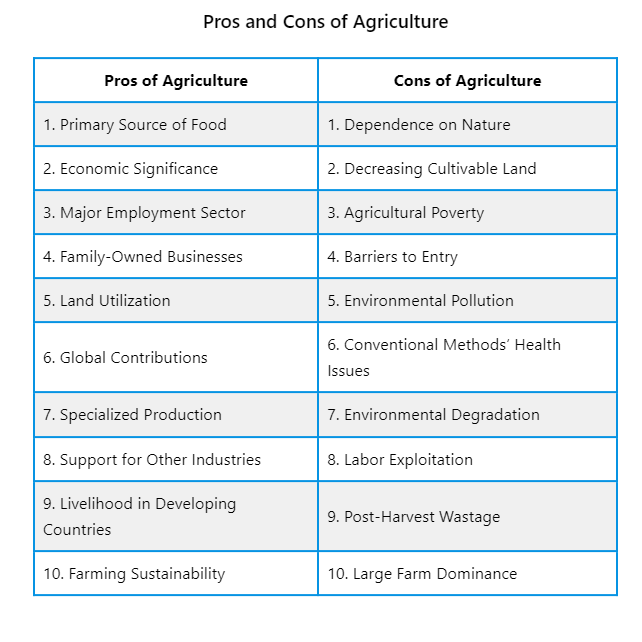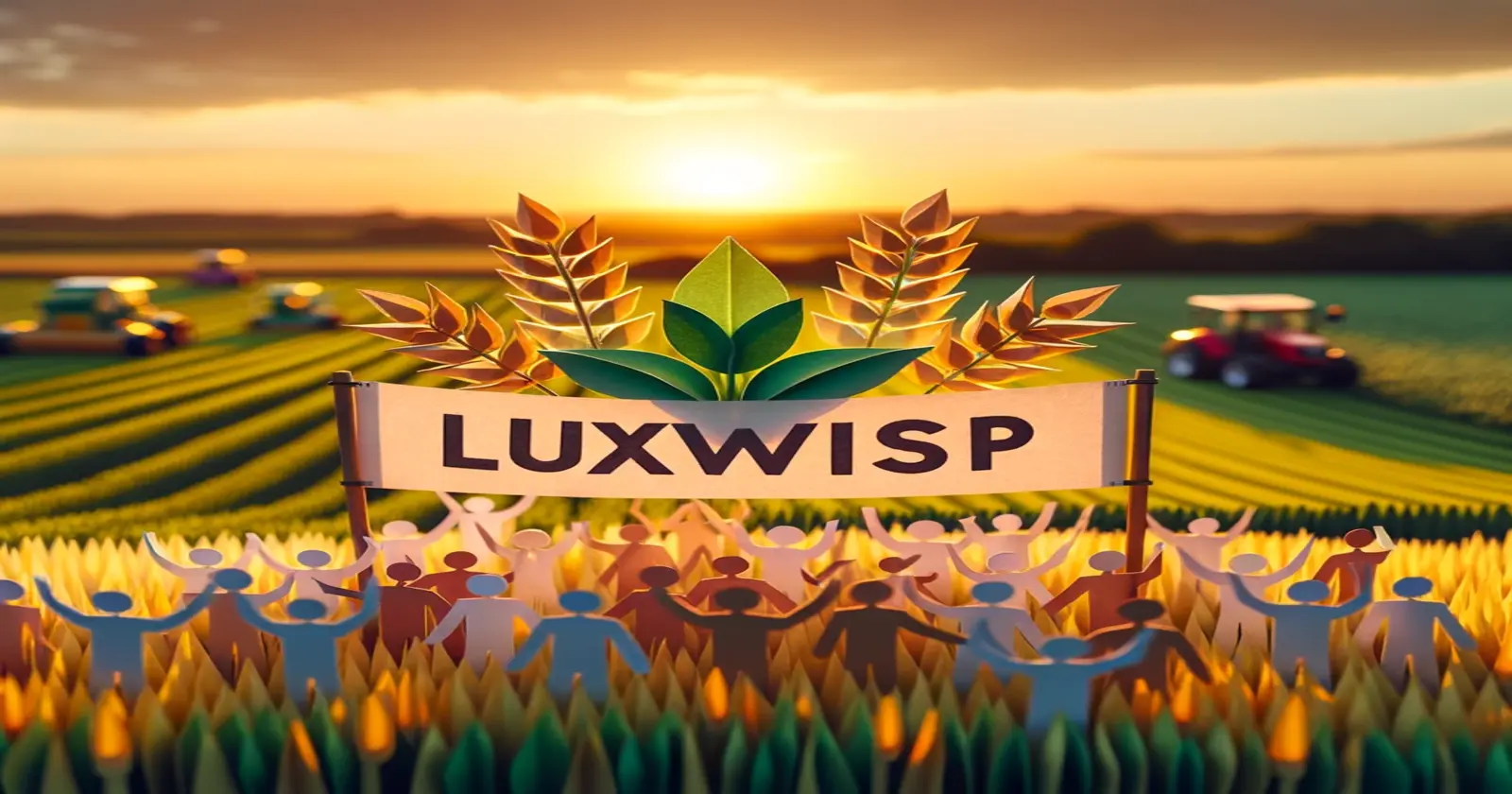Agriculture, as one of the oldest human activities, has both its advantages and challenges.
The pros of agriculture are providing human food, reducing soil erosion, supporting other industries, enhancing farming sustainability, lowering greenhouse gas emissions, and ensuring low-cost food production. It promotes eco-friendly farming techniques, boosts farmers’ markets, and combats starvation and poverty.
The cons of agriculture are being nature-dependent, having a risk with decreasing cultivable land, widespread agricultural poverty due to limited capital, difficult agricultural entry, risk of environmental pollution, and health issues from conventional methods. This can lead to environmental degradation and exploitation of labor, including children.
This article dives into agriculture’s double-edged sword, exploring how it feeds billions, drives economies, and yet, can exploit workers and harm our planet. It’s a deep look into agriculture’s pros and cons, presenting a balanced view of this indispensable sector.

Key Takeaways:
- Agriculture provides human food and reduces soil erosion.
- It supports other industries and enhances farming sustainability.
- Agriculture reduces world hunger and feeds the growing population.
- It minimizes soil erosion, preserves water sources, and transforms human life.

Agriculture Fact Sheet
- Top U.S. Farm Products: Cattle and calves, corn, and soybeans are the top 3 U.S. farm products.
- Family Farms: 86% of U.S. agricultural products sold are produced on family farms or ranches.
- U.S. GDP Contribution: Farming accounts for about 0.7% of the U.S. gross domestic product.
- Farmers’ Revenue: After accounting for input costs, farmers and ranchers receive only 8 cents out of every dollar spent on food at home and away from home.
- Employment in U.S. Agriculture: Agriculture employs over 24 million Americans.
- Land Usage: About 40% of the land in the United States is used for agriculture, including cropland and pastureland.
- U.S. Contribution to Global Production: U.S. farmers produce 10% of the world’s wheat and 20% of the world’s beef, pork, and lamb.
- Peanut Production: U.S. peanut farmers produce 3 million tons of peanuts each year.
- Number of U.S. Farms: There are 2 million U.S. farms, of which 97% are family-owned.
- Large Farm Dominance: The remaining 3% of farms that are very large dominate the industry.
- Global Employment in Agriculture: Approximately 27% of the world’s workforce was engaged in agriculture in 2019.
- GDP Contribution in Developing Countries: In some developing countries, agriculture contributes to over 25% of the Gross Domestic Product.
- Agricultural Output Growth Rate: The global agricultural output’s growth rate decreased to 1.93% annually during the period 2011–20, down from 2.72% during 2001–10.
- Livelihood Reliance in Developing Countries:
- Farming remains the primary livelihood option for three-quarters of the global population living below the poverty line.
- Financial Impact in India:
- Indian farmers face financial losses of approximately $12.5 billion annually due to post-harvest wastage.
- Fertilizer Usage in the U.S.:
- The use of the three primary fertilizer nutrients increased by 215% from 1960 to 2004.
- Usage peaked at 146 nutrient pounds per acre per year in 2004.
- Soil Fertility Decline:
- Globally, between 20-50% of irrigated soils have become excessively saline, leading to reduced fertility.
- European Union’s Common Agricultural Policy (CAP) Impact:
- The CAP has provided a financial safety net for farmers, bolstering the appeal of the farming profession.
| Pros of Agriculture | Cons of Agriculture |
|---|---|
| Primary Source of Food | Dependence on Nature |
| Economic Significance | Decreasing Cultivable Land |
| Major Employment Sector | Agricultural Poverty |
| Family-Owned Businesses | Barriers to Entry |
| Land Utilization | Environmental Pollution |
| Global Contributions | Conventional Methods’ Health Issues |
| Specialized Production | Environmental Degradation |
| Support for Other Industries | Labor Exploitation |
| Livelihood in Developing Countries | Post-Harvest Wastage |
| Farming Sustainability | Large Farm Dominance |
| Low Greenhouse Gas Emissions | Risk of Monoculture |
| Low-Cost Food Production | Fluctuating Market Prices |
| Combating Starvation and Poverty | Water Usage |
| Local Markets Boost | Climate Change Impact |
| Diverse Range of Products | Debt Traps |
| Soil Preservation | Loss of Traditional Farming Methods |
| Fertilizer Utilization | Resistance to Pesticides |
| Safety Nets | Supply Chain Vulnerabilities |
| Economic Diversity | Health Concerns from GMOs |
| Tourism Opportunities | Land Ownership Disparities |
| Cultural Significance | Dependence on Fossil Fuels |
| Educational Opportunities | Loss of Cultural Landscapes |
| Renewable Resources | Potential Soil Exhaustion |
| Carbon Sequestration | Loss of Pollinators |
| Biodiversity | Over-reliance on Government Subsidies |
Pros of Agriculture

- Primary Source of Food: Agriculture is fundamental to human survival. Consider the vast variety of foods we consume daily – from the rice in sushi rolls to the wheat in our bread. U.S. farmers alone contribute 10% of the world’s wheat, underlining the vast scale at which agriculture operates. Without this backbone, global diets would be restricted, and malnutrition would be rampant.
- Economic Significance: Agriculture is an economic powerhouse. In the U.S., a developed country, it contributes to 1% of its GDP – this might seem small, but it translates to billions of dollars. For developing countries, the stakes are even higher. Agriculture can represent up to a quarter of their GDP, acting as the primary source of revenue and trade.
- Major Employment Sector: Think about every farmer, rancher, agricultural scientist, tractor mechanic, or farm equipment seller – they all owe their livelihood to agriculture. The sheer numbers are staggering; nearly 1 in 4 people globally were involved in agriculture in 2019. In the U.S. alone, this industry keeps over 24 million people employed.
- Family-Owned Businesses: Agriculture is more than just a sector; it’s a family legacy. The fact that 86% of U.S. agricultural products are from family farms emphasizes the familial foundations of this industry. This structure not only ensures the transfer of time-tested farming practices across generations but also aids in preserving traditions and local cultures.
- Land Utilization: While cities and towns continue expanding, agricultural lands play an essential role in preserving natural habitats. The 40% of U.S. land dedicated to agriculture doesn’t just produce food – it provides habitats for diverse fauna, aids in groundwater recharge, and acts as a carbon sink. Agriculture strikes a balance between human needs and ecological preservation.
- Global Contributions: A country’s agricultural prowess has ripple effects across the globe. For instance, if U.S. beef production were to halt, global beef prices might skyrocket given it contributes 20% of the world’s supply. This level of contribution ensures stability in global food markets, preventing potential scarcities and price volatilities.
- Specialized Production: Specialization in agriculture leads to remarkable feats. U.S. peanut production, at 3 million tons annually, is a testament to this. Such specialization means consumers can enjoy peanut butter, candy, and various other peanut-derived products consistently without major price or availability concerns.
- Support for Other Industries: Agriculture’s influence extends far beyond food. The cotton in our shirts, the rubber in our tires, and the biofuels in some vehicles – all trace back to agriculture. By supplying raw materials, agriculture forms the foundational layer for myriad industries, enhancing economic interconnectivity.
- Livelihood in Developing Countries: In many regions, agriculture isn’t just a job; it’s a lifeline. For three-quarters of the global population living below the poverty line, farming provides sustenance and a beacon of hope. Through agriculture, they have the means to feed their families, earn an income, and potentially elevate their socioeconomic status.
- Farming Sustainability: With the looming threat of climate change, sustainable practices in agriculture have never been more crucial. Techniques like crop rotation not only replenish the soil but also reduce the need for chemical fertilizers. By mitigating soil erosion and promoting biodiversity, modern agriculture is stepping up to environmental challenges.
- Low Greenhouse Gas Emissions: Unlike many sectors, particularly fossil fuel-based energy industries, agriculture has the potential to minimize greenhouse gas emissions. For instance, by practicing agroecology and no-till farming, farmers can significantly reduce carbon release into the atmosphere. Additionally, the use of green manures and compost instead of synthetic fertilizers reduces nitrous oxide emissions, a potent greenhouse gas.
- Low-Cost Food Production: Agriculture leverages economies of scale and advanced technologies to produce food at competitive costs. For instance, through crop breeding and mechanization, farmers can produce high yields, leading to a surplus that translates to affordable prices for consumers. This is crucial for global food security.
- Combating Starvation and Poverty: In many regions, especially developing countries, agriculture serves as the backbone of the economy and a vital source of sustenance. Countries in Africa, for instance, rely heavily on subsistence farming, where families grow food primarily for their own consumption, directly reducing their dependency on external food sources and enhancing community resilience.
- Local Markets Boost: Directly tied to agriculture, local farmers’ markets bolster community economies. In places like Portland, Oregon, or Austin, Texas, local markets foster a sense of community, enable farmers to fetch fair prices, and ensure consumers get fresh, often organic, local produce.
- Diverse Range of Products: Beyond just food, agriculture feeds into multiple industries. For instance, corn is not only a staple food but is also used to produce biofuel and bioplastics, while cotton, another agricultural product, supports the vast global textile industry.
- Soil Preservation: Agriculture, when practiced sustainably, can protect soil from erosion. Techniques like contour plowing or the use of cover crops, which have been adopted in places like the American Midwest, can significantly decrease topsoil loss, ensuring fertile grounds for future generations.
- Fertilizer Utilization: The advanced use of fertilizers, particularly in precision agriculture, ensures maximum yield with minimal waste. By increasing fertilizer use by 215% from 1960 to 2004, U.S. farmers showcased how targeted nutrient application can lead to bountiful harvests without excessive resource expenditure.
- Safety Nets: The European Union’s CAP, for instance, supports farmers by stabilizing their revenues in the face of volatile market prices or unpredictable weather conditions. This not only ensures a stable food supply but also maintains rural areas’ socio-economic health.
- Economic Diversity: Agriculture acts as an economic stabilizer. For countries heavily reliant on a single industry, like oil, having a robust agricultural sector, as seen in nations like Brazil with its soy production, can buffer against economic downturns.
- Tourism Opportunities: Agritourism, as seen in vineyards in regions like Tuscany, Italy, or Napa Valley, USA, offers a unique blend of leisure and education, drawing tourists and providing an additional revenue stream for farmers.
- Cultural Significance: Celebrations like the rice planting festivals in Southeast Asia or grape harvest festivals in Europe tie communities to their agricultural roots, preserving ancient traditions and fostering a sense of shared identity.
- Educational Opportunities: Educational farm tours, popular in areas like Vermont, USA, give urban dwellers insights into farming life, bridging the urban-rural divide and fostering a deeper appreciation for the origins of their food.
- Renewable Resources: Bamboo, which grows rapidly, has emerged as a sustainable alternative to wood in construction and paper industries, exemplifying how agriculture can pivot towards more sustainable production methods.
- Carbon Sequestration: Agroforestry, practiced in regions like the Amazon Basin, combines trees and shrubs with crops, serving as a carbon sink. Trees in these systems absorb and store more carbon than is released, offsetting emissions from other sectors.
- Biodiversity: Organic farms, such as those in parts of California, USA, often refrain from using pesticides, promoting a thriving ecosystem where beneficial insects, pollinators, and birds coexist, fostering a balanced environment.
Cons of Agriculture

- Dependence on Nature: Agriculture’s reliance on weather and natural phenomena make it inherently risky. For instance, a sudden shift in weather patterns can lead to droughts which, as seen in California from 2012 to 2017, resulted in billions of dollars in economic losses. Farmers must prepare for such unpredictable events, yet even with modern technology, a severe flood or pest infestation can devastate an entire season’s crop yield, directly influencing both food supply and farmer revenue.
- Decreasing Cultivable Land: The continuous urban sprawl, especially in rapidly developing countries like China, means that arable land is being lost to concrete jungles. This isn’t just a spatial concern; it’s a sustainability one. Less land to cultivate means fewer resources to support an ever-growing global population, potentially escalating food prices and scarcity issues.
- Agricultural Poverty: The disparity in earnings for farmers, especially when compared to the overall food industry, is alarming. In the U.S., despite its vast agricultural output, farmers and ranchers get only 8 cents out of every dollar spent on food. This disproportion indicates a significant imbalance in the value chain, with middlemen and corporations gaining more at the expense of those who produce.
- Barriers to Entry: The capital-intensive nature of farming—requiring land, equipment, seeds, and more—poses challenges for newcomers. Furthermore, in places like Europe, where land is often inherited, new entrants without a family background in farming find it exceedingly difficult to break into the industry.
- Environmental Pollution: The repercussions of over-fertilization can be dire. The Mississippi River Basin showcases this with its annual dead zone in the Gulf of Mexico, a result of nutrient runoff, primarily from agricultural regions. The U.S.’s increased fertilizer use, peaking at 146 nutrient pounds per acre, emphasizes the scale of potential environmental harm.
- Conventional Methods’ Health Issues: Repeated exposure to certain pesticides and chemicals, like the widely-used glyphosate, has been linked to health concerns. Farmworkers, particularly in regions without strict regulatory oversight, can face higher risks of ailments due to prolonged exposure.
- Environmental Degradation: Overfarming and unsuitable agricultural practices compromise soil health. The Aral Sea disaster, partially caused by diverting water for cotton cultivation, demonstrates the environmental consequences of mismanaged agriculture. Moreover, the reported 20-50% saline-affected irrigated soils globally underscore the magnitude of soil degradation.
- Labor Exploitation: The agricultural sectors in some regions, especially in parts of Asia and Africa, have a dark side: child labor and unethical treatment of workers. Cocoa farms in West Africa, a prime source of the world’s chocolate, have repeatedly come under scrutiny for child labor and poor working conditions.
- Post-Harvest Wastage: The inefficiencies post-harvest, often due to lack of storage or transport facilities, result in substantial losses. India’s staggering $12.5 billion annual loss highlights the scale of the challenge, reflecting the need for infrastructure investments and better supply chain management.
- Large Farm Dominance: A market dominated by a few large players can limit opportunities for smaller entities and reduce competitive pricing. In the U.S., even though 97% of farms are family-owned, the powerful 3% can influence prices, policies, and practices in ways that might not benefit the broader farming community or consumers.
- Risk of Monoculture: Focusing heavily on single crop production, such as the U.S.’s emphasis on corn and soybeans, can create vulnerabilities in ecosystems. Monocultures are more susceptible to pest infestations and disease outbreaks. Additionally, with decreased plant diversity, soil nutrients can be depleted faster, reducing the overall soil health.
- Fluctuating Market Prices: The price volatility for agricultural products directly affects farmers’ income. For instance, a bumper crop year can unexpectedly drive down prices due to oversupply, while a poor harvest can spike prices. This unpredictability makes it challenging for farmers to gauge their potential earnings and plan their expenses.
- Water Usage: Agriculture is a significant consumer of freshwater. In areas already facing water scarcity, this can exacerbate the problem. For instance, irrigating vast monocultures like cornfields can deplete local water resources, leaving less available for other community uses and natural ecosystems.
- Climate Change Impact: Agriculture’s role in climate change is multifaceted. For example, deforestation for agricultural land releases carbon stored in trees. Also, rice cultivation emits methane, a potent greenhouse gas. As climate patterns shift, farming regions may face unpredictable weather, affecting crop yields.
- Debt Traps: Taking the example of India, where many farmers rely on loans to purchase seeds and equipment, an unforeseen poor harvest can mean they’re unable to repay their debts. This cycle can lead to chronic debt and, in extreme cases, has led to farmer suicides.
- Loss of Traditional Farming Methods: As large-scale industrial agriculture becomes dominant, centuries-old sustainable farming practices risk being lost. These traditional methods often have a minimal ecological footprint and are tailored to local conditions, making them more resilient than some modern techniques.
- Resistance to Pesticides: The overuse of pesticides can lead to pests developing resistance, requiring even more potent chemicals to achieve the same effect. This escalating cycle can result in harm to the environment and increased costs for farmers.
- Supply Chain Vulnerabilities: The 2020 pandemic showcased how fragile global supply chains could be. With disruptions in transportation and labor, agricultural products faced delays or were unable to reach markets, leading to food waste and economic loss.
- Health Concerns from GMOs: While GMOs can improve crop yields and resistance, there’s public concern about their long-term health effects on humans. The lack of comprehensive studies and the dominance of biotech companies in this sector have fueled these concerns.
- Land Ownership Disparities: Large swaths of agricultural land are often owned by a few entities or individuals, leading to power imbalances. For instance, in many Latin American countries, a small percentage of landowners control a majority of the arable land, which can lead to socioeconomic inequalities and tensions.
- Dependence on Fossil Fuels: Mechanized farming relies heavily on fossil fuels for machinery and transportation. This dependence not only contributes to greenhouse gas emissions but also makes the agricultural sector vulnerable to fuel price fluctuations.
- Loss of Cultural Landscapes: As modern agricultural practices take over, significant cultural and historical farming landscapes risk being altered or destroyed, leading to a loss of heritage and traditional knowledge.
- Potential Soil Exhaustion: Without sustainable practices like crop rotation, continuous farming can strip the soil of essential nutrients. Over time, this can render land unproductive, forcing the abandonment of fields and the search for new arable land.
- Loss of Pollinators: The decline of bee populations, vital for pollinating many crops, can be linked to certain agricultural practices, such as the use of specific pesticides. This loss can significantly impact crop yields and biodiversity.
- Over-reliance on Government Subsidies: In regions like the European Union, where farmers heavily rely on subsidies from policies like the Common Agricultural Policy (CAP), there’s a risk of market distortions. While subsidies can offer a safety net, over-reliance can reduce the incentive for innovation and efficiency in the sector.

Understanding the Benefits of Agriculture
Agriculture holds immense benefits, not just for the economy, but also for the sustainability of our planet and human life.
By enhancing farming practices, it paves the way for a sustainable future, helping to mitigate the effects of climate change.
Moreover, it plays a pivotal role in reducing world hunger, providing food to growing populations, and ensuring food security.
Farming Sustainability Enhancement

Farming Sustainability Enhancement, a significant benefit of agriculture, involves practices that meet our current food and fiber needs without compromising the ability of future generations to meet their own needs. This approach is crucial in response to the ongoing climate change crisis.
Sustainable enhancement in agriculture includes:
- Utilizing organic farming practices, which avoid harmful pesticides and genetically modified organisms.
- Implementing farming methods that conserve water, improve soil health, and reduce greenhouse gas emissions.
- Promoting local food systems which decrease transportation emissions and support local economies.
These practices not only ensure the longevity of farming, but also contribute to the overall health of our planet. With careful planning and implementation, the farming industry can play a significant role in mitigating the impacts of climate change.
Reducing World Hunger
Building on the concept of farming sustainability enhancement, tackling the pressing issue of world hunger is another significant benefit associated with agriculture.
Agricultural activities, led by dedicated farmers, create a reliable source of food that nourishes the global population. Through the production of various crops, farmers generate a steady supply of food, essential in reducing world hunger.
Modern agricultural practices have boosted crop yields, ensuring that more food reaches hungry mouths. Additionally, the diversification of crops enhances nutritional intake, contributing to overall health and wellness.
It’s clear that without the tireless efforts of farmers and the robust agricultural sector, the fight against world hunger would be much more challenging. Thus, agriculture plays a critical role in feeding the world and reducing hunger.
Agriculture’s Support for Other Industries

Agriculture is pivotal for industries like manufacturing, textiles, and pharmaceuticals, providing essential raw materials. Key farming models include:
- Commercial Farming: Offers bulk raw materials for mass production industries.
- Industrial Agriculture: Uses modern techniques to ensure a consistent supply.
- Contract Farming: Agreements between farmers and companies guarantee a steady raw material supply.
- Cooperative Farming: Groups small-scale farmers to meet industrial demands.
Agriculture’s significance extends beyond food, fostering economic growth by supporting various sectors. However, its challenges can impact these industries, emphasizing the importance of sustainable practices.
Role of Agriculture in Reducing Hunger
Around 828 million people globally suffer from chronic hunger. Agriculture, particularly small-scale farming, is key to addressing this issue, as most of the world’s food comes from these small plots.
Soil quality greatly influences crop yield and is vital in combating hunger. Agricultural research focuses on sustainable methods that preserve soil and optimize water use.
Innovations in this field lead to drought and disease-resistant crops, enhancing food production. However, agriculture alone isn’t the solution. Equitable food distribution, market access for small farmers, and climate resilience are also crucial. While agriculture plays a significant role in curbing hunger, broader strategies are needed.
Dilemmas in Sustainable Farming

Many farmers grapple with the decision to adopt sustainable farming due to its pros and cons. While it offers environmental benefits and long-term productivity, the transition has its challenges:
- High initial costs, especially for research pesticides and biofertilizers, can be burdensome for small-scale farmers.
- Possible decrease in yield during the early stages of transition.
- A steep learning curve requiring extensive knowledge and training.
However, recognizing its long-term advantages, many farmers, with adequate support and resources, are inclined to embrace sustainable practices.
Exploitative Practices in Agriculture

While sustainable farming practices can provide long-term benefits, it’s important to acknowledge that the agricultural industry is not without its exploitative practices. For instance, the use of child labor, especially in developing countries, is a widespread issue. The industry also has a history of underpaying and overworking migrant workers.
Another exploitative practice is the excessive use of natural resources, such as water and soil. Overuse of these resources has led to significant environmental degradation, threatening the sustainability of farming in the long run.
The table below illustrates some of these exploitative practices:
| Exploitative Practice | Consequence | Potential Solution |
|---|---|---|
| Child Labor | Human rights violation | Enforcement of labor laws |
| Overworking and underpaying laborers | Labor exploitation | Fair pay policies |
| Excessive use of natural resources | Environmental degradation | Sustainable farming practices |
Conclusion
Agriculture, as a fundamental pillar of human civilization, brings with it a multitude of benefits. It supports economies, provides employment, and ensures food security for billions worldwide. However, its intricacies also introduce challenges, from environmental concerns to economic disparities. As the world’s population grows and the climate changes, the delicate balance between the pros and cons of agriculture becomes increasingly critical. To harness its full potential, it’s imperative to address its shortcomings, ensuring a sustainable and equitable future for all.










